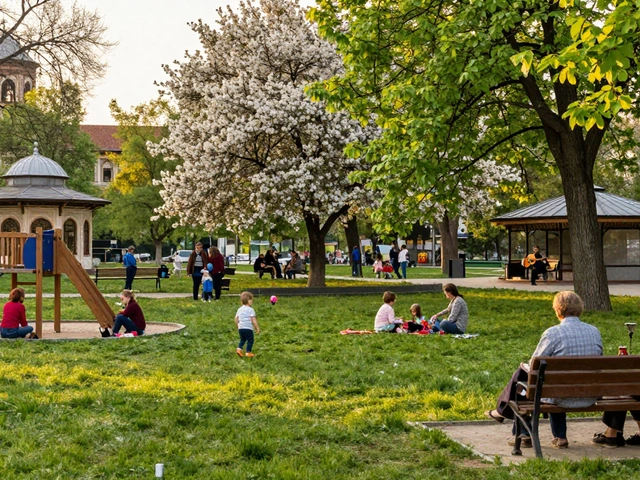If you’ve ever found yourself lost in the details of how trams work on İstiklal Street, or wondered why the Bosphorus is so perfectly blue, Istanbul has science museums that will scratch that itch. This city isn’t just about historic mosques, busy bazaars, and delicious simit—there’s a thriving world of discovery for anyone who geeks out about science, technology, or natural wonders.
Let’s be real—most people don’t immediately think of Istanbul when they hear “must-visit science museums.” But that’s their loss. Locals know that places like the Rahmi M. Koç Museum deliver sensory overload for gadget lovers, history fans, and curious kids. You can literally walk through an old submarine, tinker with mechanical inventions, and even try out hands-on experiments right by the Golden Horn.
And it’s not just about old machines or dusty fossils. Science centers in Istanbul go all-in with interactive planetarium shows, 3D simulations, and special events for everything from robotics to biology. Families, school groups, and solo explorers will all find something to make them say “wow.” Don’t be surprised if you plan for an hour and end up spending the whole afternoon. Stay tuned for the best spots, smart visiting hacks, and some quirky finds you might otherwise miss.
- Science Hotspots You Can't Miss in Istanbul
- Rahmi M. Koç Museum: A Techie’s Playground
- Planetariums and Space Centers: Shooting for the Stars
- Hands-On Fun for Families and Kids
- Quirky Finds and Hidden Scientific Gems
- Tips for Making Your Istanbul Museum Day Awesome
Science Hotspots You Can't Miss in Istanbul
If you’re ready to nerd out in Istanbul, you’ve got options that go way beyond history museums and art galleries. This city is stacked with spots where hands-on science, wild experiments, and cool exhibits take center stage. Let's break down the places you just can't skip if you want a real science fix here.
The first place nearly everyone recommends is the Rahmi M. Koç Museum. This isn’t your standard museum. It’s huge—right on the edge of the Golden Horn—and covers everything from vintage cars to giant steam engines. Kids can press buttons, climb inside cockpits, and even check out original locomotives. They have a working submarine, too (ex-British Navy), and you can go inside for a tour, which is rare in any city.
If you're into the stars, head over to the Istanbul Planetarium at Kültür University in Bakırköy. Local schools often visit, but regular folks can book tickets for public shows as well. Their space shows are in Turkish, but the visuals are worth it even if your language skills aren’t perfect.
Another gem is the Istanbul Museum of The History of Science and Technology in Islam near Gülhane Park. Here, you’ll see early inventions from Islamic scholars—like astrolabes, clocks, and some seriously clever medical tools. Not only will you geek out over the engineering, but you’ll also get why science and curiosity have always been a big deal in Turkish culture.
For biology lovers, the Turkish Natural History Museum inside Istanbul University (Vezneciler) is a throwback to old-school science collections. You’ll see fossils, minerals, and stuffed animals from Turkey’s different regions. It’s not flashy, but if you want to explore what’s unique about Turkey’s geology and wildlife, this is the place.
- Rahmi M. Koç Museum: Tech, transportation, hands-on fun
- Istanbul Planetarium: Star shows, space science
- Istanbul Museum of The History of Science and Technology in Islam: Ancient inventions, engineering
- Natural History Museum: Local geology, fossils, and animals
Pro tip: Weekends can get packed with families and school field trips, especially at the big museums. If you want shorter lines and more room to try out the exhibits, go on weekday mornings or later in the afternoon. And don’t forget to check each museum’s website in advance—some spots update hours or require online booking, especially after big holidays like bayram.
Rahmi M. Koç Museum: A Techie’s Playground
If you’re hunting for one spot that covers everything from steam engines to submarines, the Rahmi M. Koç Museum on the Hasköy shoreline is where Istanbul’s science lovers go for a hands-on fix. This place is a must-see among Istanbul museums if you’re into technology, history, or things that move and make noise.
The museum is set inside old Ottoman-era buildings that used to be an anchor factory. Spread out along the Golden Horn, it’s packed with real vehicles you can touch, climb into, and sometimes operate. You won’t just find old cars and trains—there are tons of detailed models, a full-size Douglas DC-3 airplane, and even a genuine TCG Uluçalireis submarine. Ever wondered what it’s like to stand at the periscope? Here’s your shot.
- Interactive Labs & Activities: Weekly science workshops for kids (in Turkish, but easy to follow), hands-on physics demos, and simple robotics activities that you can actually get your hands on.
- Classic Cars & Trams: Wander right up to old local Istanbul trams and cars that once zipped down city streets. There’s even an Istanbul-made Anadol car on display.
- Steam Engines & Maritime: Huge working models and a collection of boats—including Ottoman-era steamers—dock along the water’s edge. Ideal if you like anything nautical.
- Science Toys & Play Areas: Younger visitors flock to the toy gallery and science play rooms, where everything is meant for tinkering.
The museum isn’t just about looking at stuff behind glass. For a small fee, you can tour inside the submarine (kids need to be 10+). Don’t miss the hands-on experiments at the science center located inside the main hall—great for both curious teens and adults.
For quick reference, here are some key numbers about the Rahmi M. Koç Museum:
| Year Opened | 1994 |
|---|---|
| Exhibit Spaces | Over 27,000 m² |
| Annual Visitors (2023) | Over 500,000 |
| Submarine Tours (2023) | 35,000+ participants |
If you want a real break, there’s a couple of decent cafés with Bosphorus views, plus a gift shop filled with science toys and Istanbul-themed souvenirs. Plan for at least two hours—three, if you’ve got little ones or gadget fanatics in your group. Get tickets ahead of time online, especially on weekends or national holidays when the place fills up with families and school kids on field trips.
Planetariums and Space Centers: Shooting for the Stars
If you’ve ever wanted to see what the night sky looks like with zero light pollution, Istanbul’s planetariums are your shortcut to jaw-dropping views. The Istanbul museums scene includes several cool spots where you can stare at virtual constellations, catch up on the latest astronomy news, or get hands-on with interactive star maps. Even on a rainy day, you can watch a simulated meteor shower or explore the surface of Mars right from your seat.
The Rahmi M. Koç Museum’s Planetarium is one of the top picks. Tucked near Hasköy, the planetarium here runs several daily shows, ranging from the basics (“What’s in the Sky Tonight?”) to deep dives into black holes and distant galaxies. Even kids who claim science is boring usually have their minds changed after watching a surround-sound space film under that huge domed screen. For adults, the detailed astronomy talks—sometimes in English—go further than any textbook ever could.
Istanbul also has science centers like the Üsküdar Science Center (Üsküdar Bilim Merkezi), which hosts regular astronomy workshops for kids and teens. Staff don’t just talk about comets—they hand out telescopes for real stargazing nights on the roof. These events fill up fast, especially during big celestial moments like a lunar eclipse or Perseid meteor shower.
"We believe that exploring space inspires both curiosity and perspective. Our visitors often say that a night under the dome feels more real than scrolling through photos online." — Dr. Cemil Tuncer, Senior Astronomer, Üsküdar Science Center
If you’re after something special, check out workshops run by Istanbul University’s Observatory. These sessions often include outdoor viewing parties, where you get to peek through massive telescopes. Just remember—before you go, check the weather and book ahead, since Istanbul’s space-loving crowd is bigger than you might guess.
Some helpful stats about visit times and visitors at major Istanbul planetariums:
| Venue | Annual Visitors | Popular Show Times | Best for |
|---|---|---|---|
| Rahmi M. Koç Museum Planetarium | 45,000+ | Weekends, 13:00 - 16:00 | All ages |
| Üsküdar Science Center | 25,500+ | After sunset, special events | Kids, teens, families |
| Istanbul University Observatory | Varies (by event) | Evenings, new moon nights | Amateur astronomers, students |
Here’s what works if you want to make the most out of your planetarium trip:
- Book your tickets online. Weekends get crowded, especially after school lets out.
- Check if the session is in Turkish or English—it’s clearly labeled on most booking sites.
- If you’re heading to an observatory event, bring a light jacket. Rooftop nights in Istanbul can get breezy, even in June.
- Don’t skip the lobby exhibits. Some of the best solar models and VR stations are right outside the main theaters.
Whether you’re a die-hard astronomer or just need a break from daily city rush, these science exhibits open up a whole new universe to explore—no passport required.

Hands-On Fun for Families and Kids
If you want kids (or yourself) to actually get excited about science, Istanbul’s museums are way more exciting than any homework assignment. Instead of just staring at displays, you get to poke around, test gadgets, and even make some noise. Most spots are designed so that nobody needs to worry about shushing the kids—curiosity is pretty much a requirement.
The Rahmi M. Koç Museum is hands-down the best place for interactive fun. It’s got a whole zone just for kids—‘Discovery Sphere’—where you can launch air rockets, make weird sounds with old radios, and even try building a simple robot with their weekend programming workshops. The museum’s outdoor section sometimes sets up mini science fairs where you and the kids can race mini-boats and mess with science experiments. Don’t skip the chance to climb aboard a real Turkish Airlines cockpit, or spin old wheels on retro trams and trains.
Another favorite for families is the Science Center inside Istanbul Technical University’s Ayazağa campus. They’re known for their live experiments, like making artificial snow (wildly popular in winter) or creating homemade lava lamps. At their weekend maker workshops, kids learn how electricity works using actual wires, batteries, and even a light bulb or two—perfect for hands-on learners.
If your crew is into the cosmos, check out the Istanbul Planetarium near Üsküdar. The seat-tilting shows are designed with younger kids in mind, and the interactive star maps let you "draw" constellations with your finger on a giant screen. Don’t be surprised if you run into a birthday party group, as it’s one of the top picks for science-themed parties in the city.
| Museum Name | Top Activity | Best Age Group | Location |
|---|---|---|---|
| Rahmi M. Koç Museum | Discovery Sphere & Weekend Workshops | 6-14 | Hasköy, Beyoğlu |
| Istanbul Technical University Science Center | Live Science Shows & Maker Labs | 7-15 | Ayazağa, Sarıyer |
| Istanbul Planetarium | Interactive Star Map Shows | 5-13 | Üsküdar |
If you want to avoid weekend crowds, plan visits on weekday afternoons. Many museums offer family discounts or free entry for kids under a certain age (usually under 6). Also, double-check websites for seasonal science fairs or special Lego robotics events—these fill up super fast. Most places allow snacks in their café areas, which helps keep everyone happy and fueled up for exploring.
Quirky Finds and Hidden Scientific Gems
If you’re the kind of person who loves stumbling onto things nobody else has found, Istanbul’s science scene is way deeper than just the big ticket museums. Beyond the well-known spots, the city hides some offbeat science nooks that even lifelong residents might not know about. These little gems are perfect for anyone who wants to see what makes Istanbul museums truly unique.
Let’s start with the Istanbul Toy Museum in Göztepe. Sure, it sounds like a kids’ hangout, but their collection has some surprisingly scientific toys—think vintage chemistry sets, classic solar system models, and old-school DIY robots. It’s a walk through the history of how science mixed with fun, and the founder, poet Sunay Akın, has a knack for picking up pieces you won’t spot elsewhere.
Another spot that deserves a shoutout is the Istanbul University Observatory, hidden on top of Beyazıt campus. If you call ahead, you can sometimes join public stargazing nights. The telescope dates back to the early days of the Republic and has helped track anything from lunar eclipses to passing comets. Pro tip: clear winter evenings mean much sharper views of Saturn’s rings.
For nature fans, the Nezahat Gökyiğit Botanical Garden in Ataşehir isn’t just about pretty flowers. Their science team grows native and rare plants, and volunteers organize workshops about plant biology that explain how the city’s urban environment is constantly changing. If you’re into biodiversity or eco-innovation, they even host small science fairs focused on climate action and sustainability in Istanbul.
You’ll find geeky gatherings too that usually fly under the radar. Istanbul hosts a bunch of science-themed board game nights, coding meetups (hello, Kadıköy’s makerspaces), and even DIY drone-building workshops. Check out local groups on Meetup or Instagram around the start of each month.
Here’s what makes these spots so useful:
- They’re rarely crowded. You get more hands-on time and better chances to talk with staff.
- They’re usually free or way cheaper than big museums.
- You get to meet real science nerds, not just casual visitors.
As Dr. Ayşe Kılıç of Istanbul University Observatory puts it:
"Science isn’t only found in textbooks or lab coats. It’s in childhood toys, in the stars over Istanbul, or in the plants growing between sidewalks. Discovering the hidden corners of science is a kind of adventure we can all share."
Just to give a snapshot, check out this table of cool hidden science stops compared to the main highlights around town:
| Hidden Gem | Main Focus | Typical Visitors Per Day | Entry Fee (₺) |
|---|---|---|---|
| Istanbul Toy Museum | Science toys, history of play | 450 | 120 |
| Istanbul University Observatory | Stargazing & space events | 45 | 0 |
| Nezahat Gökyiğit Botanical Garden | Plant science, sustainability | 700 | 0 |
| Rahmi M. Koç Museum | Industrial tech, transport, hands-on exhibits | 2500 | 450 |
Bottom line: Istanbul’s got a quirky underbelly for science lovers. You just need to know where to look. Follow the events pages, ask around, and don’t be shy about dropping in on a workshop—you might just stumble on the next cool thing in town.
Tips for Making Your Istanbul Museum Day Awesome
Don’t just show up and hope for the best—planning is key to a great museum outing in Istanbul. The Istanbul museums scene can surprise you with crowd sizes or closures, especially on Mondays when a lot of places take a break, including some science gems. Always check official websites or social media for up-to-date opening hours, since public holidays and Ramadan sometimes bring sudden schedule changes.
Start your day early, especially for spots like the Rahmi M. Koç Museum, which draws families, school trips, and tourists all at once. Mornings are way less crowded, so you’ll actually get to play with the hands-on exhibits without waiting in line. Booking tickets online (when possible) saves you from wasting time in long ticket queues—plenty of museums now have QR code entry with your smartphone.
Public transport is your best friend in Istanbul. Traffic can turn a 10-minute trip into a one-hour crawl, especially if you’re heading to the Golden Horn or Sultanahmet areas. Use the tram, metro, or even ferries. For the Rahmi M. Koç Museum, Haliç Metro Station is within easy walking distance. Don’t forget to bring your Istanbulkart so you can jump on and off buses or trams without hassle.
Pack light but smart. Most museums have bag checks, and big backpacks make you a magnet for bored security guards. Stuff your bag with water, snacks, and a phone charger—many science centers have free WiFi, and there’s always something worth Googling or sharing. Wear comfy shoes; bigger museums easily involve a few kilometers of walking.
If you’re bringing kids, look up workshops or kids’ zones ahead of time. Some spots run daily science fun like slime-making, robotics labs, or telescope sessions for all ages, but you might need to sign up in advance, especially on weekends. The Rahmi M. Koç Museum and Istanbul's planetariums both get high marks from local parents for well-organized, interactive events.
Finally, don’t try to do everything in one shot. Istanbul’s best science museums pack in so much that you’ll burn out trying to “see it all.” Pick your favorite exhibits or activities, plan a break for Turkish coffee (most bigger museums have decent cafes or at least a canteen), and leave time to browse the gift shop for quirky science toys and local souvenirs. A bit of preparation goes a long way toward making your Istanbul day out a win for everyone—geeks and non-geeks alike.













